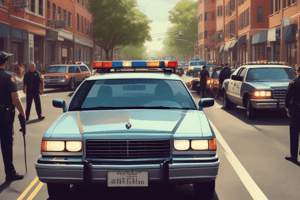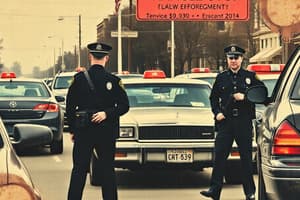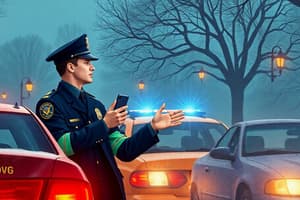Podcast
Questions and Answers
What is the primary goal of every traffic stop, according to the provided guidelines?
What is the primary goal of every traffic stop, according to the provided guidelines?
Which of the following actions is MOST effective in minimizing negative outcomes during a traffic stop?
Which of the following actions is MOST effective in minimizing negative outcomes during a traffic stop?
During a traffic stop, why should an officer describe the violation in terms of what the vehicle did, rather than what the driver did?
During a traffic stop, why should an officer describe the violation in terms of what the vehicle did, rather than what the driver did?
What should an officer do if a driver becomes argumentative during a traffic stop?
What should an officer do if a driver becomes argumentative during a traffic stop?
Why is it important to emphasize the seriousness of a traffic violation during a stop?
Why is it important to emphasize the seriousness of a traffic violation during a stop?
What specific action should an officer AVOID during a traffic stop, even if the driver was clearly in the wrong?
What specific action should an officer AVOID during a traffic stop, even if the driver was clearly in the wrong?
What should an officer do immediately before ending a traffic stop?
What should an officer do immediately before ending a traffic stop?
When should an officer provide their rank, name, and badge or ID number to the driver?
When should an officer provide their rank, name, and badge or ID number to the driver?
During a traffic stop, an officer notices a passenger in the backseat upon approach. Where should the officer initially position themselves for cover?
During a traffic stop, an officer notices a passenger in the backseat upon approach. Where should the officer initially position themselves for cover?
An officer observes a vehicle with a popped or damaged ignition during a traffic stop. What does this most likely suggest?
An officer observes a vehicle with a popped or damaged ignition during a traffic stop. What does this most likely suggest?
Under what circumstance is it most appropriate for an officer to use the 'no-approach tactic' during a traffic stop?
Under what circumstance is it most appropriate for an officer to use the 'no-approach tactic' during a traffic stop?
Why might an officer choose to approach a vehicle on the passenger's side during a traffic stop?
Why might an officer choose to approach a vehicle on the passenger's side during a traffic stop?
What is the primary reason for instructing the driver to roll down all the windows on the driver's side of the vehicle?
What is the primary reason for instructing the driver to roll down all the windows on the driver's side of the vehicle?
An officer is approaching a vehicle at night during a traffic stop. In which hand should the flashlight be held, and why?
An officer is approaching a vehicle at night during a traffic stop. In which hand should the flashlight be held, and why?
During a traffic stop, if there are no passengers in the backseat, where should an officer position themselves?
During a traffic stop, if there are no passengers in the backseat, where should an officer position themselves?
What is the first thing an officer should do when approaching a stopped vehicle?
What is the first thing an officer should do when approaching a stopped vehicle?
During which phase of a traffic stop does the officer typically transition from assessing the initial unknown risk to managing potential high-risk factors?
During which phase of a traffic stop does the officer typically transition from assessing the initial unknown risk to managing potential high-risk factors?
An officer initiates a traffic stop for a vehicle with a broken tail light. During the stop, the officer learns that the driver has a prior conviction for armed robbery. According to the guidelines, at what point does this traffic stop potentially transition from unknown risk to high risk?
An officer initiates a traffic stop for a vehicle with a broken tail light. During the stop, the officer learns that the driver has a prior conviction for armed robbery. According to the guidelines, at what point does this traffic stop potentially transition from unknown risk to high risk?
Which action is most indicative of transitioning a traffic stop from 'unknown risk' to 'high risk' based on reasonable belief?
Which action is most indicative of transitioning a traffic stop from 'unknown risk' to 'high risk' based on reasonable belief?
In what order should an officer conduct a traffic stop?
In what order should an officer conduct a traffic stop?
An officer has initiated a traffic stop and, upon approaching the vehicle, observes furtive movements by the occupants, along with the handle of what appears to be a weapon protruding from under the driver's seat. What immediate adjustments should the officer make to their approach?
An officer has initiated a traffic stop and, upon approaching the vehicle, observes furtive movements by the occupants, along with the handle of what appears to be a weapon protruding from under the driver's seat. What immediate adjustments should the officer make to their approach?
During a traffic stop, what should an officer do if a driver presents an out-of-state license with an 'X' gender designation?
During a traffic stop, what should an officer do if a driver presents an out-of-state license with an 'X' gender designation?
An officer notices inconsistencies between a vehicle's registration and its visible VIN, make, model, and year. What is the MOST appropriate next step?
An officer notices inconsistencies between a vehicle's registration and its visible VIN, make, model, and year. What is the MOST appropriate next step?
During a traffic stop, a driver informs an officer that they have a concealed weapon in the vehicle, but does not proactively present their concealed weapon license. According to the content, what is the appropriate course of action for the officer?
During a traffic stop, a driver informs an officer that they have a concealed weapon in the vehicle, but does not proactively present their concealed weapon license. According to the content, what is the appropriate course of action for the officer?
During a traffic stop, which of the following formats is acceptable as proof of current insurance?
During a traffic stop, which of the following formats is acceptable as proof of current insurance?
What immediate action should an officer take if they suspect a driver or passenger is experiencing an opioid overdose during a traffic stop?
What immediate action should an officer take if they suspect a driver or passenger is experiencing an opioid overdose during a traffic stop?
An officer stops a vehicle for speeding. The driver presents a valid Florida driver's license and proof of insurance. What additional piece of information should the officer verify regarding the vehicle?
An officer stops a vehicle for speeding. The driver presents a valid Florida driver's license and proof of insurance. What additional piece of information should the officer verify regarding the vehicle?
A driver discloses they have a concealed weapon but does not present a concealed weapon license. What level of suspicion is required for the officer to request the license and weapon location?
A driver discloses they have a concealed weapon but does not present a concealed weapon license. What level of suspicion is required for the officer to request the license and weapon location?
A driver is unable to provide a driver's license. What alternative information can the officer request to confirm the driver's identity, according to the content?
A driver is unable to provide a driver's license. What alternative information can the officer request to confirm the driver's identity, according to the content?
During a high-risk traffic stop, which factor elevates an unknown-risk stop to high-risk?
During a high-risk traffic stop, which factor elevates an unknown-risk stop to high-risk?
During which step of a high-risk traffic stop does the primary officer coordinate with other officers?
During which step of a high-risk traffic stop does the primary officer coordinate with other officers?
What should an officer do first upon identifying a vehicle or suspect matching a BOLO (Be On the Lookout) description during a potential high-risk traffic stop?
What should an officer do first upon identifying a vehicle or suspect matching a BOLO (Be On the Lookout) description during a potential high-risk traffic stop?
In what situation is a vehicle MOST likely to be impounded following a traffic stop?
In what situation is a vehicle MOST likely to be impounded following a traffic stop?
Which action is LEAST important for an officer during a high-risk traffic stop?
Which action is LEAST important for an officer during a high-risk traffic stop?
Which of the following is NOT a specified reason to classify a traffic stop as 'high-risk'?
Which of the following is NOT a specified reason to classify a traffic stop as 'high-risk'?
Steps 5 through 10 of a high-risk traffic stop primarily involve what actions by the primary officer?
Steps 5 through 10 of a high-risk traffic stop primarily involve what actions by the primary officer?
An officer is initiating a high-risk traffic stop. After identifying the vehicle and location, what is the MOST crucial next step?
An officer is initiating a high-risk traffic stop. After identifying the vehicle and location, what is the MOST crucial next step?
During a traffic stop conducted on the roadway, what is the recommended positioning of the primary officer's vehicle?
During a traffic stop conducted on the roadway, what is the recommended positioning of the primary officer's vehicle?
What is the primary reason a backup officer should avoid using front emergency lighting during a traffic stop?
What is the primary reason a backup officer should avoid using front emergency lighting during a traffic stop?
In an unknown risk traffic stop, if occupants attempt to exit the vehicle, the decision to order them back inside is based on what?
In an unknown risk traffic stop, if occupants attempt to exit the vehicle, the decision to order them back inside is based on what?
During the visual assessment phase of a traffic stop, what might a significantly lowered rear end of the vehicle indicate?
During the visual assessment phase of a traffic stop, what might a significantly lowered rear end of the vehicle indicate?
Before exiting the patrol vehicle during a traffic stop, what is the most important action an officer should take?
Before exiting the patrol vehicle during a traffic stop, what is the most important action an officer should take?
Why is it important to quietly secure the patrol vehicle door after exiting during a traffic stop?
Why is it important to quietly secure the patrol vehicle door after exiting during a traffic stop?
During a traffic stop, why should the backup officer approach the driver's vehicle along the passenger's side of the primary officer's vehicle?
During a traffic stop, why should the backup officer approach the driver's vehicle along the passenger's side of the primary officer's vehicle?
An officer should be prepared to transition to a high-risk vehicle stop based on what?
An officer should be prepared to transition to a high-risk vehicle stop based on what?
Flashcards
Goal of Traffic Stops
Goal of Traffic Stops
To promote driver education and safer roadways.
Professional Conduct
Professional Conduct
Minimizes negative outcomes during traffic stops.
Procedural Justice
Procedural Justice
Practicing fairness during interactions with drivers.
Greeting Procedures
Greeting Procedures
Signup and view all the flashcards
Listening to Drivers
Listening to Drivers
Signup and view all the flashcards
Command Presence
Command Presence
Signup and view all the flashcards
Ending the Interaction
Ending the Interaction
Signup and view all the flashcards
Officer Safety Awareness
Officer Safety Awareness
Signup and view all the flashcards
Left Side Traffic Stop
Left Side Traffic Stop
Signup and view all the flashcards
Offset-Angle Position
Offset-Angle Position
Signup and view all the flashcards
Backup Officer
Backup Officer
Signup and view all the flashcards
No Front Emergency Lights
No Front Emergency Lights
Signup and view all the flashcards
Approach Strategy
Approach Strategy
Signup and view all the flashcards
Visual Assessment
Visual Assessment
Signup and view all the flashcards
Silent Exit
Silent Exit
Signup and view all the flashcards
High-Risk Vehicle Stop
High-Risk Vehicle Stop
Signup and view all the flashcards
Lethal Opioid Drugs
Lethal Opioid Drugs
Signup and view all the flashcards
Emergency Opioid Antagonist
Emergency Opioid Antagonist
Signup and view all the flashcards
Driver's License Verification
Driver's License Verification
Signup and view all the flashcards
Social Security Number
Social Security Number
Signup and view all the flashcards
Insurance Information
Insurance Information
Signup and view all the flashcards
Third Sex or Gender Option
Third Sex or Gender Option
Signup and view all the flashcards
Respectful Interaction
Respectful Interaction
Signup and view all the flashcards
Concealed Weapon License
Concealed Weapon License
Signup and view all the flashcards
Unknown Risk Traffic Stop
Unknown Risk Traffic Stop
Signup and view all the flashcards
Cautious Approach
Cautious Approach
Signup and view all the flashcards
High-Risk Traffic Stop Criteria
High-Risk Traffic Stop Criteria
Signup and view all the flashcards
Committing Forcible Felony
Committing Forcible Felony
Signup and view all the flashcards
Scanning the Scene
Scanning the Scene
Signup and view all the flashcards
Armed and Dangerous
Armed and Dangerous
Signup and view all the flashcards
Checking Interior
Checking Interior
Signup and view all the flashcards
Driver's C-Pillar
Driver's C-Pillar
Signup and view all the flashcards
Active Violent Felony Warrant
Active Violent Felony Warrant
Signup and view all the flashcards
Tactical Advantage
Tactical Advantage
Signup and view all the flashcards
Passenger Side Approach
Passenger Side Approach
Signup and view all the flashcards
Signs of Stolen Vehicle
Signs of Stolen Vehicle
Signup and view all the flashcards
No-Approach Tactic
No-Approach Tactic
Signup and view all the flashcards
High-Risk Traffic Stop
High-Risk Traffic Stop
Signup and view all the flashcards
Steps of a High-Risk Traffic Stop
Steps of a High-Risk Traffic Stop
Signup and view all the flashcards
Step 1: Identify Vehicle/Suspect
Step 1: Identify Vehicle/Suspect
Signup and view all the flashcards
Step 2: Identify Location
Step 2: Identify Location
Signup and view all the flashcards
Coordination with Officers
Coordination with Officers
Signup and view all the flashcards
Position Patrol Vehicles
Position Patrol Vehicles
Signup and view all the flashcards
Issuing Commands
Issuing Commands
Signup and view all the flashcards
Concluding the Stop
Concluding the Stop
Signup and view all the flashcards
Study Notes
Traffic Stops
- The goal of every traffic stop is to promote driver education and safer roadways
- Traffic stops are tense, officer interaction with those in vehicles can shape community perception of law enforcement.
- Minimize negative/unsafe outcomes by practicing professionalism and training
- Steps to reduce tension during a traffic stop
- Politely greet driver and passengers. Introduce yourself and your agency. Explain the reason for the stop.
- Allow the driver to speak and explain their perspective. Maintain polite, focused demeanor, demonstrate active listening.
- Request driver's license, registration, and proof of insurance.
- Clearly explain why the stop was made, describing the violation.
- Emphasize the seriousness of the violation, its relation to safety, such as risk of crash, etc. Avoid lecturing the person.
- Keep the detention time as short as possible.
- End the stop with "thank you for your cooperation," or "drive safely." Provide your rank, name, badge, or ID.
- Remain aware of officer safety throughout the stop. Refer drivers to the appropriate person in your department if unable to answer questions.
- If the encounter becomes heated, respond with professionalism, a level head and a reasonable approach to de-escalate. Consider language barriers.
- Traffic stops are a frequent officer activity.
- A traffic stop is the lawful and temporary detention of a pedestrian or vehicle driver concerning traffic enforcement.
- Officer safety and situational awareness are crucial.
- Choose a safe parking place with a clear view of traffic flow. Avoid areas that obstruct or endanger other drivers.
- Traffic stops begin when an observable violation merits a stop.
- All stops are initially considered "unknown risk."
- A traffic stop may be conducted for:
- A traffic violation
- To assist a motorist with a vehicle problem
- With reasonable suspicion a crime has been committed or committed.
- Investigation of suspicious behavior or a vehicle or occupant matching a BOLO description.
- Factors to consider prior to stopping a driver:
- Unsafe conditions (e.g., heavy traffic, construction, etc.).
- Urgent emergency calls or transporting prisoners.
- Steps for an unknown risk traffic stop:
- Follow the vehicle until safe to stop.
- Notify dispatch of the stop.
- Select a safe location.
- Activate emergency equipment to signal the stop.
- Park your patrol vehicle.
- Visually assess the vehicle and occupants.
- Exit the patrol vehicle.
- Use appropriate approach techniques.
- Interact with the driver and passengers.
- Choose a course of action.
- Strategies & techniques for defensive driving and safe distance.
- Vehicle and passenger observations for unique identifiers (glasses, hats, hair, any details).
Studying That Suits You
Use AI to generate personalized quizzes and flashcards to suit your learning preferences.





